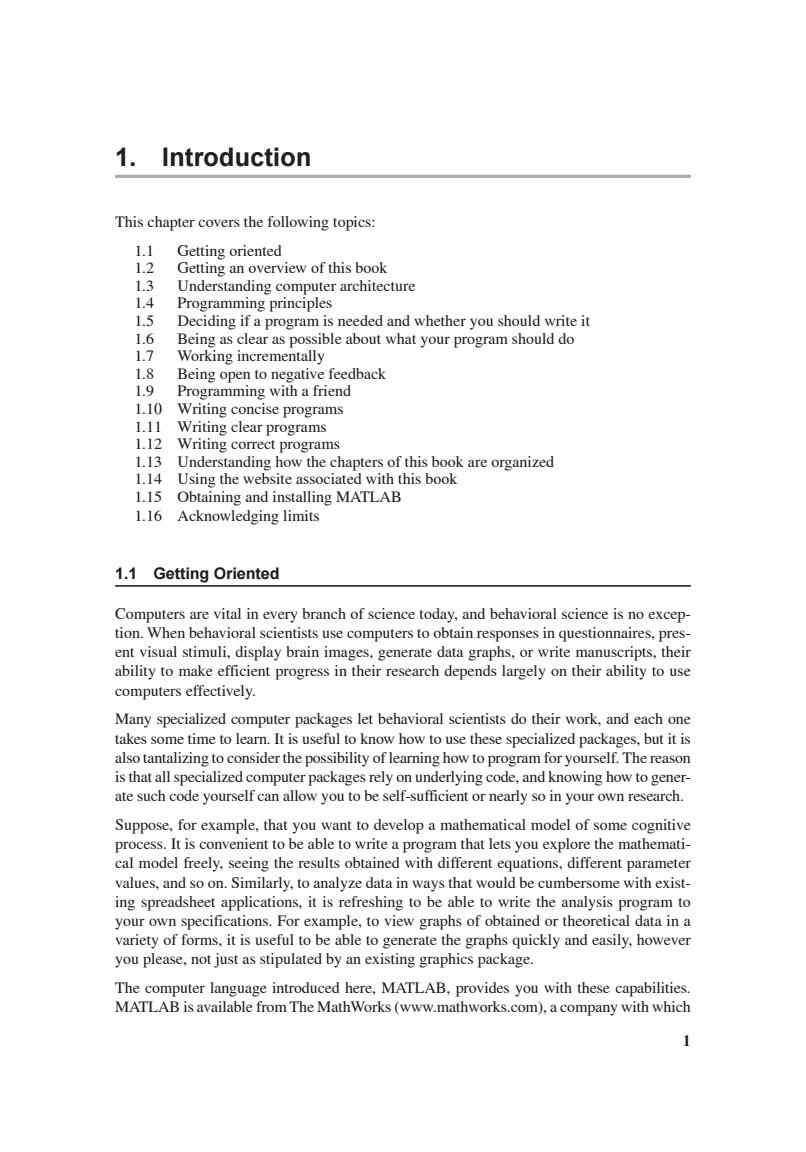正在加载图片...

1.Introduction This chapter covers the following topics: 11 Getting oriented 15 Deciding if a program is needed and whether you should write it e outhydo orking increme 110 Writing concise programs 12 Writing clear programs ng con program the website ass heerifibogtaeoeganized 1.15 Obtaining and installing MATLAB 1.16 Acknowledging limits 1.1 Getting Oriented Computers are vital in every branch of science today,and behavioral science is no excep- tion.When behavioral scientists use computers to obtain responses in questionnaires.pres- ent visual stimuli,display brain images,generate data graphs,or write manuscripts,their ability to make efficient progress in their research depends largely on their ability to use computers effectively. Many specialized computer packages let behavioral scientists do their work,and each one takes some time to learn.It is useful to know how to use these specialized packages,but it is nal3tocciderthepoabyofleamimehowopoeamforJyog The reason s that ompu d knowing how to gene Suppose,for example.that I: with differe nd P ly,it is write the to vio aphs of obtained or theo in a erate the graphs quickly and easily.however you please,not just as stipulated by an existing graphics package. The computer language introduced here.MATLAB.provides you with these capabilities. MATLAB is available from The MathWorks(www.mathworks.com),a company with which1 1. Introduction This chapter covers the following topics: 1.1 Getting oriented 1.2 Getting an overview of this book 1.3 Understanding computer architecture 1.4 Programming principles 1.5 Deciding if a program is needed and whether you should write it 1.6 Being as clear as possible about what your program should do 1.7 Working incrementally 1.8 Being open to negative feedback 1.9 Programming with a friend 1.10 Writing concise programs 1.11 Writing clear programs 1.12 Writing correct programs 1.13 Understanding how the chapters of this book are organized 1.14 Using the website associated with this book 1.15 Obtaining and installing MATLAB 1.16 Acknowledging limits 1.1 Getting Oriented Computers are vital in every branch of science today, and behavioral science is no exception. When behavioral scientists use computers to obtain responses in questionnaires, present visual stimuli, display brain images, generate data graphs, or write manuscripts, their ability to make efficient progress in their research depends largely on their ability to use computers effectively. Many specialized computer packages let behavioral scientists do their work, and each one takes some time to learn. It is useful to know how to use these specialized packages, but it is also tantalizing to consider the possibility of learning how to program for yourself. The reason is that all specialized computer packages rely on underlying code, and knowing how to generate such code yourself can allow you to be self-sufficient or nearly so in your own research. Suppose, for example, that you want to develop a mathematical model of some cognitive process. It is convenient to be able to write a program that lets you explore the mathematical model freely, seeing the results obtained with different equations, different parameter values, and so on. Similarly, to analyze data in ways that would be cumbersome with existing spreadsheet applications, it is refreshing to be able to write the analysis program to your own specifications. For example, to view graphs of obtained or theoretical data in a variety of forms, it is useful to be able to generate the graphs quickly and easily, however you please, not just as stipulated by an existing graphics package. The computer language introduced here, MATLAB, provides you with these capabilities. MATLAB is available from The MathWorks ( www.mathworks.com ), a company with which